L-4 (Submarine No. 43)
1916-1922
(Submarine No. 43: displacement 450 (surface), 548 (submerged); length 167'5"; beam 17'5"; draft 13'7"; speed 14 knots (surface), 10.5 knots (submerged); complement 28; armament 1 3-inch, 4 18-inch torpedo tubes.; class L-1)
L-4 (Submarine No. 43) was laid down on 23 March 1914 at Quincy, Mass., by Fore River Shipbuilding Co. as a subcontract for Electric Boat Co., Groton, Conn.; launched on 3 April 1915; and sponsored by Mrs. Stephen A. Gardner.
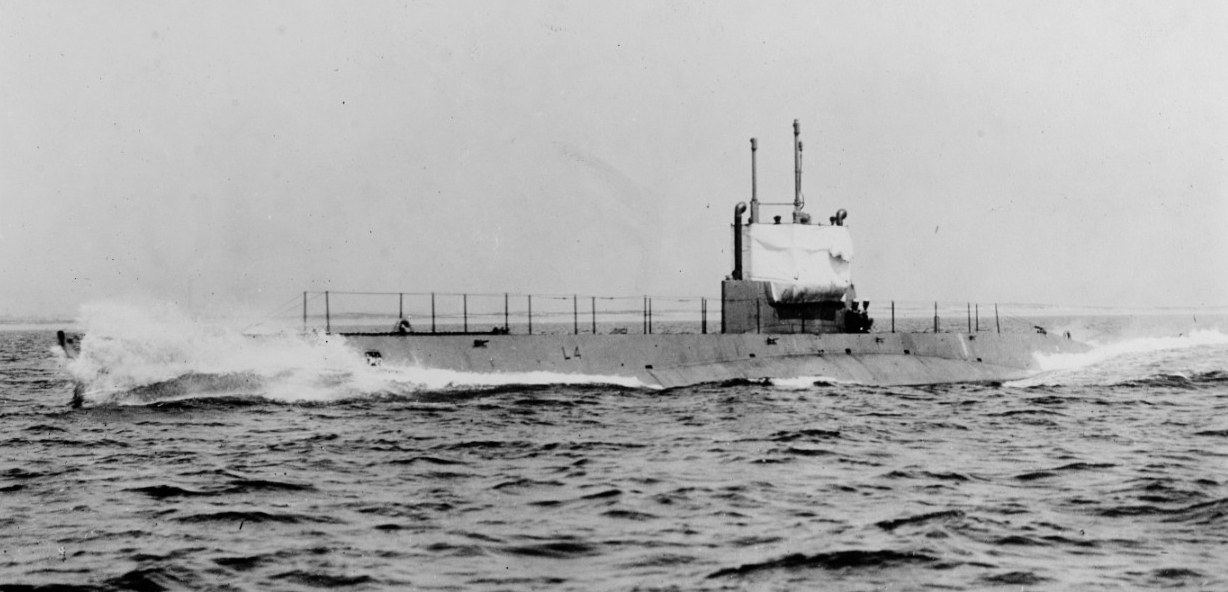
Commissioned at the Boston [Mass.] Navy Yard, on 4 May 1916, Lt. (j.g.) Lewis Hancock, Jr. in command, L-4 was initially assigned to the Fifth Division, Submarine Flotilla, Atlantic Fleet, as of 5 May 1916, and she conducted her shakedown in the waters off New England (4 May-22 June 1916). After these exercises, she proceeded to the Philadelphia [Pa.] Navy Yard where she remained until 1 July. L-4 operated with Division Five (1-14 July) until the need for battery repairs forced her in to New London, Conn. She remained there through 13 September, and then proceeded to the Boston Navy Yard in company with MacDonough (Destroyer No. 9). Both arrived later that day. After a short overhaul, she departed Boston on 27 October and continued to conduct training in the waters off New England until 2 December. The submarine conducted her first preliminary torpedo practice in Block Island (R.I.) Sound on 28 November. Making her way southward via the Delaware Breakwater (5-7 December); Hampton Roads, Va. (8 December); Norfolk Navy Yard, Portsmouth, Va. (8-18 December), She arrived at Key West, Fla. (23-30 December) where she spent the Christmas holidays before arriving at Havana, Cuba, on 30 December.
Having spent the New Years’ holidays at Havana, L-4 cleared the Cuban capital on 2 January 1917 and arrived, later that day at Key West. Remaining there until 22 January, she got underway bound for Pensacola, Fla., via the Dry Tortugas (22-26 January) and arriving at her destination on 28 January. She spent the succeeding weeks operating along the Gulf coast from Pensacola and Mobile, Ala. (14-21 February) well into March. During this time the Atlantic Fleet was conducting its annual winter training in the waters off Cuba when the German resumption of unrestricted submarine warfare on 1 February, resulted in increased tensions with the U.S. The fleet initially consolidated in Guacanayabo Bay, Cuba, then re-located to the sheltered waters of the lower Chesapeake Bay and the York River, Va. L-4 was dispatched to Galveston, Texas, during this time, and was then forced to go to Pensacola, Fla. where she was required to engage in engine repair work that required the removal of deck plates and the hoisting of a burnt out armature. Making her way back to the Virginia capes via Key West (30-31 March), L-4 arrived at Hampton Roads on 5 April.
The day following her arrival, [6 April 1917], the U.S. declared war on Imperial Germany and entered the World War. The day of this declaration, L-4 shifted to the Norfolk Navy Yard (6-16 April). Upon clearing the yard on the 16th, she moved up the York River and joined the fleet assets at Yorktown, Va. The submarines of the flotilla operated in the Chesapeake Bay conducting tactical exercises with a number of the fleet’s surface vessels in Tangier Sound (30 April-4 May). On 4 May, Bushnell (Submarine Tender No. 2), along with L-1 (Submarine No. 40), L-2 (Submarine No. 41), L-3 (Submarine No. 42), and L-4 departed from York Spit, Va., bound for the Philadelphia (Pa.) Navy Yard, and arrived the next day. On 6 May, L-3 and L-4 collided with Swallow (Minesweeper No. 4) at the Philadelphia Navy Yard. Adm. Henry T. Mayo, Commander, Atlantic Fleet, issued letters of reprimand to the commanding officers of L-3 and L-4 for their improper handling of their boats and “carelessness in the performance of duty”.
In June 1917, Vice Adm. William S. Sims, Commander, U.S. Naval Forces in European Waters, cited British success in using submarines as submarine hunter-killers in antisubmarine warfare (ASW). The Allied submarines, with their lower profiles, could approach U-boats more stealthily than larger surface patrol vessels. On 2 July, Adm. William S. Benson, Chief of Naval Operations, ordered the twelve most suitable submarines on the Atlantic coast be fitted out for duty in European waters. L-4 underwent extensive overhaul at Philadelphia, to prepare her for distant service. On 14 November, the boat departed Philadelphia and conducted submerged and surface maneuvers off Lewes, Del., and returned that night.
L-4, in company L-1, L-2; L-3; L-4; L-9 (Submarine No. 49); L-10 (Submarine No. 50); L-11 (Submarine No. 51); E-1 (Submarine No. 24); Bushnell (with Capt. Thomas C. Hart, Commander, Submarine Flotilla embarked); and Fulton (Submarine Tender No. 1), cleared Philadelphia on 18 November 1917 and proceeded to New London, Conn. (Base No. 22), arriving on 20 November. She then conducted maneuvers in Long Island Sound (20-29 November) before moving on to the Torpedo Station at Newport, R.I. From there, L-4 departed on 4 December, bound for European waters via Melville, R.I. Having charted a direct course to the Azores, Hart’s force ran into a gale which scattered them and required them to pause and re-assemble at the Royal Dockyards at Bermuda (Base No. 24) on 13 December. After a period at Bermuda, L-4 departed on 1 January 1918 bound for the Azores. She arrived at Ponta Delgada (Base No. 13) in company with Genesee (Fleet Tug No. 55), L-3, and E-1 on 12 January 1918. Dispatched to the British Isles, Bushnell, Genesee, and the submarines L-1, L-2, L-4, L-10, and L-11 stood out from Ponta Delgada on 22 January. They reached Queenstown [Cobh], Ireland (Base No. 6) on 27 January 1918.
Upon arrival in the war zone, in order to differentiate them from the British L-class boats, the U.S. submarines were re-designated with the suffix “A” (American) and the letters and numerals identifying the U.S. boats were painted onto the fairwaters of each. The commander of the forward deployed U.S. submarines was Capt. Thomas C. Hart on board the tender Bushnell (Submarine Tender No. 2). Hart was later replaced by Cmdr. Wilhelm L. Friedell on 21 June. While deployed to Ireland, however, the submarines were subject to the command of Adm. Sir Lewis Bayly, RN, Commander-in-Chief, Coast of Ireland, and his commander of submarines, Capt. M. Eric Nasmith, RN (later Dunbar-Nasmith) who exercised operational control. Bayly initially ordered Hart to deploy only one of his submarines at a time at sea, and that Royal Navy officers were to always be informed of departures and returns. Their patrol area was also to be limited to seaward of the Fastnet Light, so as to keep clear of British patrols and to avoid potentially fatal “friendly-fire” incidents. The base at Queenstown, however, proved unsatisfactory for Lt. Cmdr. Harold M. Bemis’ Division Five, as it was also serving as the headquarters for the surface patrol forces. As a result, the U.S. submarines were relocated to a base at Berehaven [Castletownbere], Bantry Bay on 5 February. In the ensuing days (6-16 February), the division trained in Bantry Bay conducting dives and tactical maneuvers under the charge of the commander of the Royal Navy’s Submarine Flotilla also based at Berehaven. U.S. submarine officers also trained with a “submarine attack war game” apparatus on board the submarine depot ship HMS Vulcan. The American submarines’ patrols were to be based on eight-day rotations, there would be eight days on patrol and eight days in port for overhaul, re-provision, and rest in preparation for the next eight-day patrol. On 1 March, AL-4 received orders to proceed to the Haulbowline yard at Queenstown with AL-2 under the escort of the sloop HMS Crocus. They secured alongside Melville (Destroyer Tender No. 2) in Queenstown on 6 March. When her maintenance work was completed, she cleared the yard and headed for a return to Berehaven.
While en route from Queenstown to Berehaven on 20 March 1918, AL-4 sighted a periscope about 300 yards broad on her starboard bow. Her commanding officer put her rudder hard right and passed over the spot where she had observed the submarine. The periscope disappeared, the enemy craft evidently diving to evade the U.S. submarine. Several weeks later, on 12 April, AL-4 sighted a submarine and fired a torpedo, but with negative results. While on patrol again within a fortnight on 24 April, AL-4 was running on the surface and sighted a submarine at a range of approximately 1,000 yards. She closed range and fired a torpedo at the suspected U-boat, but it never detonated. AL-4 then made for her with the intention of ramming, but the German boat dived too quickly and escaped with no further contact. The submarine, on 1 May, returned to her base at Berehaven. On 18 May. AL-4 was underway while on patrol when on a dive an inexperienced crewmember opened the wrong valve and caused a loss of control that placed the submarine in danger. The situation was quickly corrected and the boat did not founder.
While underway on 1 June 1918, in poor visibility, the submarine spotted Terry (Destroyer No. 25) about 4,000 yards astern. When the destroyer spotted AL-4, she changed course and sped toward the submarine. When the submarine deployed a smoke grenade, it exploded and caused Terry to believe that she was being fired upon. The destroyer opened fire with her forward gun, and eventually straddled the submarine. The submarine then detonated two smoke grenades which deployed appropriately and she lay to. With that the destroyer ceased firing and proceeded south while dispatching a warning that there was a German U-boat reported in the area. AL-4 returned to her base the next day.
The boat got underway for her eighth war patrol on 12 July 1918. En route, she engaged in a training exercise with target runs on AL-2 in Bantry Bay. Having completed the exercise, she cleared the bay en route to patrol station QA via Route A. At 7:08 a.m., she sighted a vessel two points on the port bow. Suspecting that it was a U-boat, AL-4 submerged to attack. As she closed with the ship, the latter proved to be a trawler. She then changed direction and later surfaced and continued her transit to the patrol area. Later, in the summer, on 30 August, AL-4 was mistaken for a U-boat while on patrol and fired upon by two different armed merchantmen four miles west of the Fastnet light. In all twenty shots were fired, despite AL-4 repeatedly flashing recognition signals. The boat, however, was not hit and she dived and ran submerged to break contact.
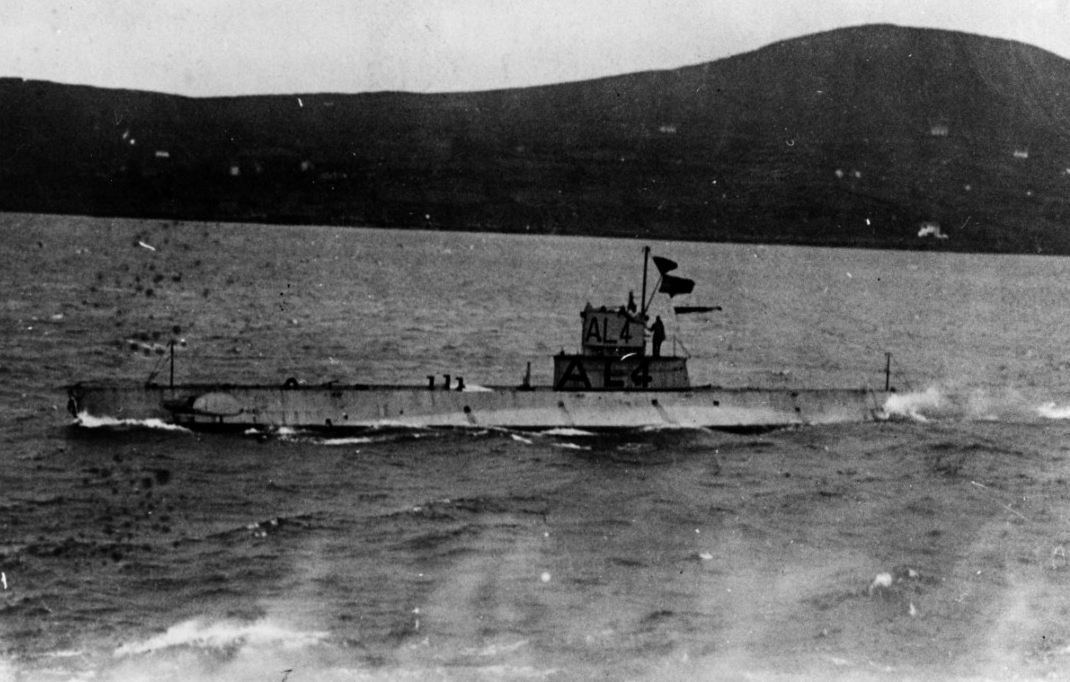
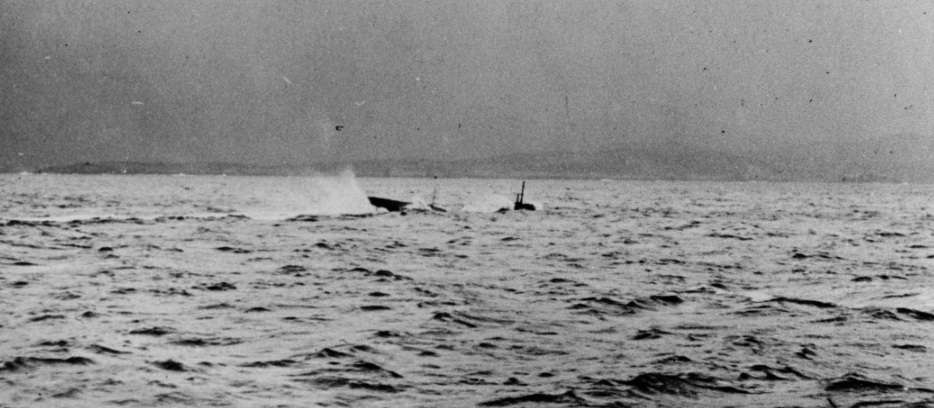
AL-4 was at Devonport, England (1 September-15 October) undergoing refit and overhaul. She received orders directing her to remain at Devonport for a week after her yard work to carry out experiments in conjunction with U.S. submarine chasers stationed there. Afterward, she was to proceed to Queenstown. She departed Plymouth, England (Base No. 27) on 21 October en route to Bantry Bay. She remained at Berehaven and operated in Bantry Bay (25 October-22 November). During this period, on 11 November, the Armistice went into effect and “The Great War” ceased.
L-4 departed Berehaven on 22 November 1918 and shifted to Queenstown. She cleared Base No. 6 on 25 November and made her way to Portland, England, in company with AL-10 (Submarine No. 50). Both submarines arrived the next day. On 7 December, 15 members of the AL-4 ship’s company traveled to Harwich, England, for duty in connection with surrendered German U-boats. The U.S. submariners assisted the board inspecting U-164, which had only been commissioned on 17 October 1918, a little over a month prior to the Armistice. On 1 January 1919, U-164 was turned over to the British in good condition (she was later broken up in 1922).
The AL-4 crewmen returned to Portland and on 3 January 1919, the submarine stood out from the harbor in company with Bushnell and the other boats of Division Five, bound for the U.S. via the Azores. Arriving at Ponta Delgada on 13 January, they departed the next day and proceeded to Bermuda. Reaching their destination on 26 January, they remained two days to refuel and re-provision and then departed for Philadelphia. They stood in to the Philadelphia Navy Yard on 1 February.
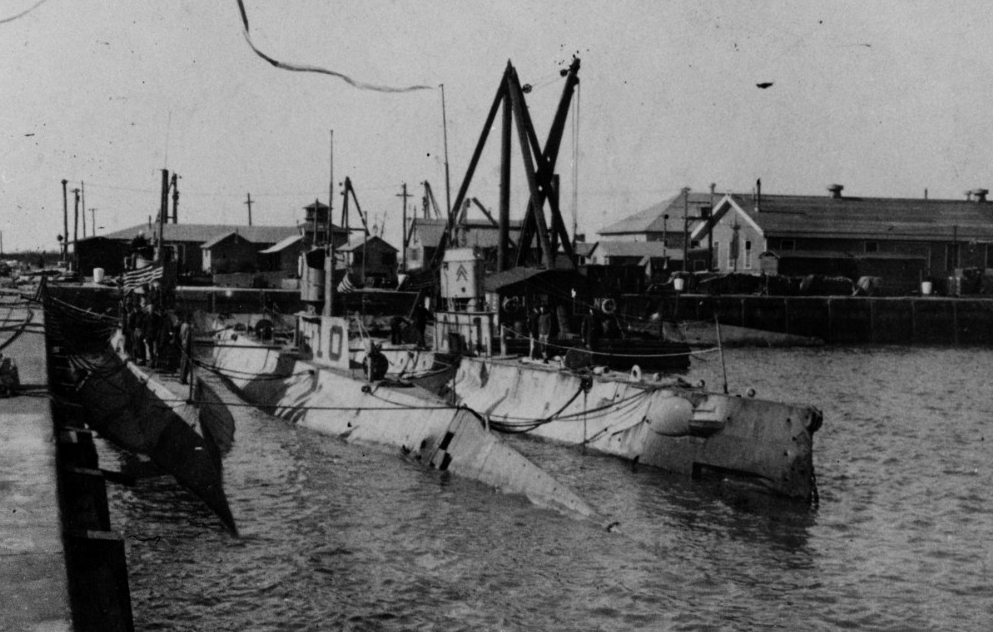
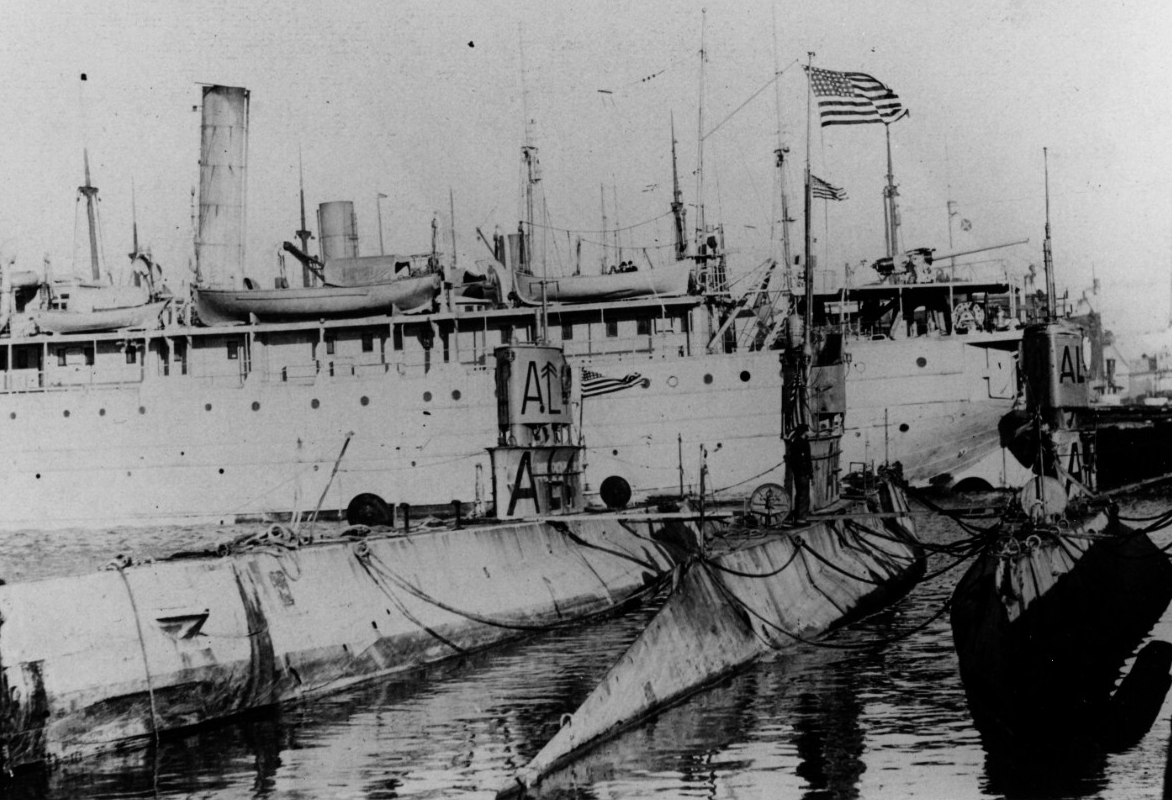
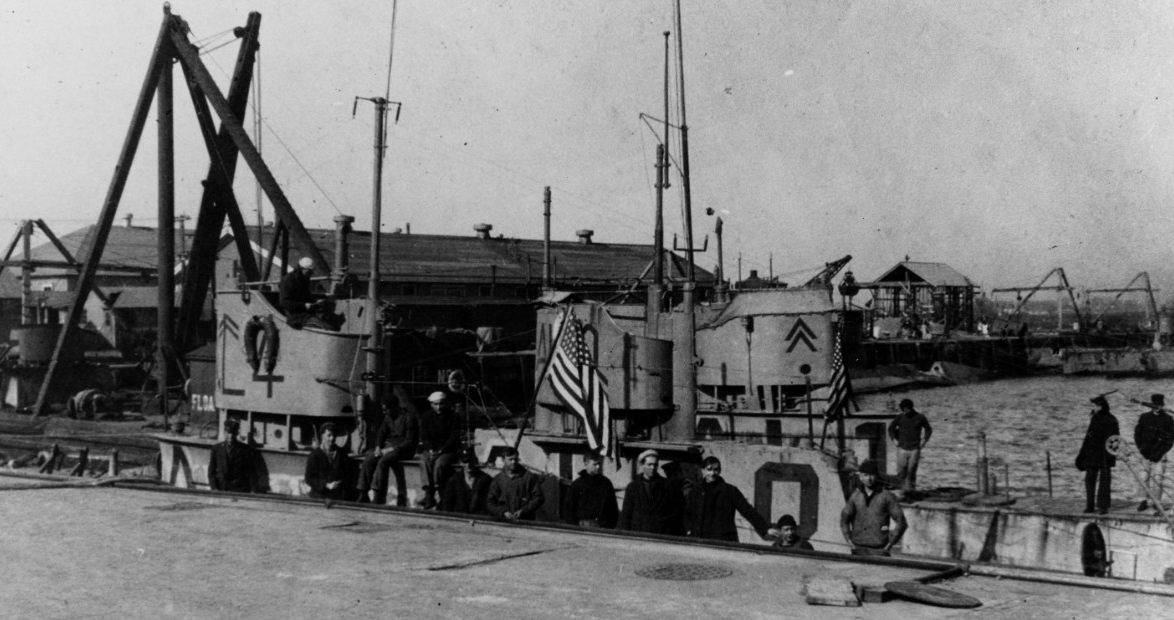
While at the Philadelphia Navy Yard, L-4 underwent a post-deployment refit and overhaul until 26 May. Clearing the yard, she shifted to Hampton Roads, where she arrived the following day. She operated from the Submarine Base through the remainder of the year. During this time L-4 in company with L-11 sailed up the Chesapeake Bay and visited the U.S. Naval Academy at Annapolis, Md. Early in January 1920, the submarine sailed up the James River to visit Richmond, Va. While at the Virginia capital, the submarine embarked Governor Westmoreland Davis and then submerged for dinner. L-4 departed Hampton Roads on 22 January bound for Bermuda, she arrived on the 25th. She stood back in to the Submarine Base on 11 February. For the remainder of the year the submarine operated from Hampton Roads, primarily in the waters off the Virginia capes, training and conducting experiments with the other units of the division developing underwater warfare tactics. During this period, on 17 July 1920, she was redesignated SS-43 as part of a Navy-wide administrative re-organization. Three days later, she and submarines L-3, L-9, L-11, M-1 (SS-47), E-1 (SS-24), and E-2 (SS-25) were made available for drydocking at the Norfolk Navy Yard.
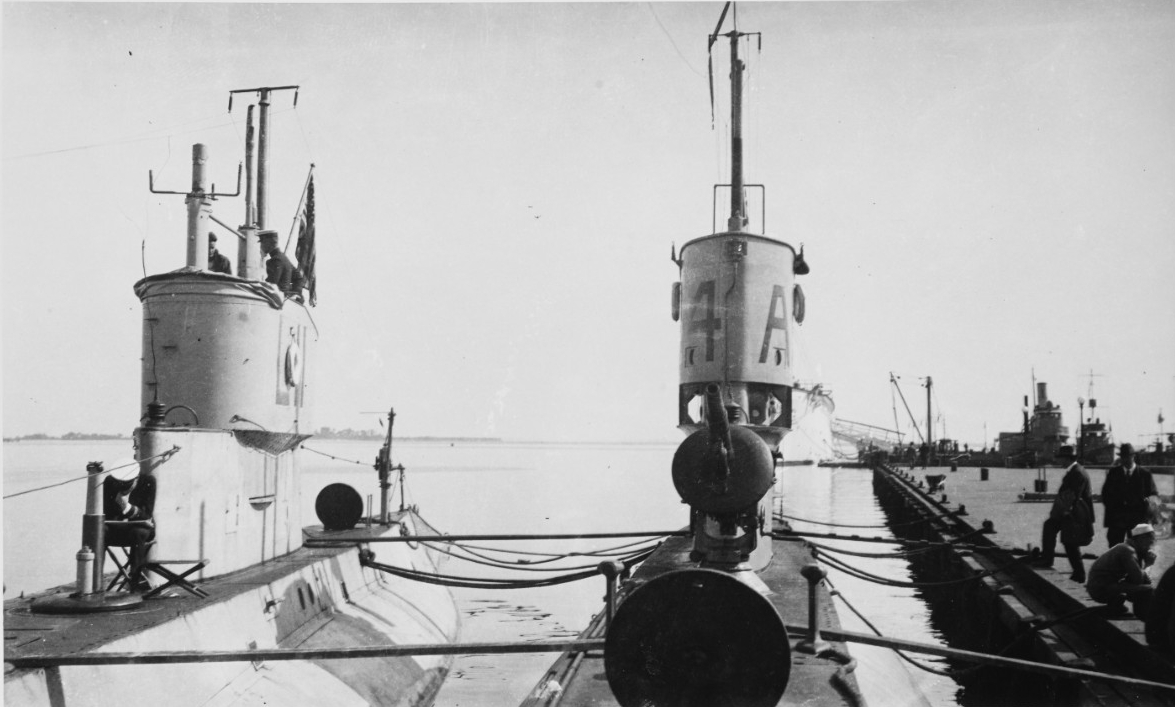
On 16 November 1920, L-4 was ordered to prepare to transfer to the Submarine Repair Division at the Philadelphia Navy Yard. She arrived at the Philadelphia Navy Yard under tow on 9 January 1921. On 26 March the Submarine Repair Division was abolished and L-4 was transferred to Submarine Division Three and remained in an inactive status at the Philadelphia Navy Yard. The Navy contemplated, on 23 August, installing the main engines of the N-class submarines in the L-class submarines. The work was to take place at Submarine Base, headquartered afloat in the patrol vessel Eagle 33 (PE-33), New London, Conn. Instead, L-4 was decommissioned at the Philadelphia Navy Yard and stricken from the Navy list on 14 April 1922. L-4 was sold to the Pottstown Steel Co., Douglassville, Pa., on 31 July 1922 for scrapping. She was delivered to the purchaser and removed from the Philadelphia Navy Yard on 6 September 1922.
| Commanding Officers | Dates of Command |
| Lt. (j.g.) Lewis Hancock, Jr. | 4 May 1916 – 18 June 1918 |
| Lt. Garnet Hulings | 18 June 1918 – 15 December 1918 |
| Lt. Cmdr. Kenneth R. R.Wallace | 15 December 1918 – 24 February 1919 |
| Lt. (j.g.) (T) Richard T. Guilbert | 24 February 1919 – 26 March 1919 |
| Lt. Raymond A. Deming | 26 March 1919 – 10 April 1919 |
| Lt. (j.g.) (T) Richard T. Guilbert | 10 April 1919 – 19 April 1919 |
| Lt. Ralph O. Davis | 19 April 1919 – 19 February 1920 |
| Lt. Archer E. King Jr. | 19 February 1920 – 27 April 1920 |
| Lt. Harold Biesemeier | 27 April 1920 – 11 January 1921 |
| Lt. John V.K. Richards | 11 January 1921 – 21 April 1921 |
| Lt. John L. Wilson | 21 April 1921 – 17 December 1921 |
| Lt. Bartley G. Furey | 17 December 1921 – 14 April 1922 |
Christopher B. Havern Sr.
4 June 2018


